
All of us have strengths that get us through difficult times, but we sometimes have trouble recognizing that they are there or remembering to draw on them. As therapists, we often spend time helping our clients to identify these strengths or build up their coping strategies. We want them to know that they can successfully get through a difficult time by using their inner talents and strengths, leaning on the support of others, and taking positive steps to cope with their emotions. In addition to talking, art can be a great way to explore and build a client’s personal strength.
I wanted to share an art therapy directive that I recently learned that is a great way to help reinforce strengths and positive coping. After doing this exercise myself at a workshop, I have tried it with some individual clients and with adult groups, always getting a positive reaction and good engagement. Although I haven’t tried it with children yet, I think this could easily be used with most ages. I have seen it be helpful for clients with a variety of struggles, including trauma, depression, serious mental illness, and substance abuse recovery.
Tree of Strength Directive:
Use a large sheet of paper (like 11×17). Lay your hand on the paper, fingers spread, with part of your arm on the paper as well. Trace your arm and hand, leaving the tips of the fingers open (picture 1). This will become the base of your tree – your arm is the trunk of the tree and the fingers are the beginning of branches.
At the end of the open finger tips, extend the drawing to create more branches. At the end of the branches, draw several large leaves, making them large enough that you can write in each one (picture 2).
On each leaf write one thing that helps you get through a difficult time – this can include personal strengths, coping strategies, enjoyable activities, and supportive people.
Color, paint, or decorate your tree as you wish (picture 3).
A few thoughts about why I like this art therapy activity and how it can be helpful:
The clear steps of this activity and the drawing foundation provided by tracing the hand and arm really make this art activity feel accessible to almost everyone and help clients have an experience of feeling “successful” in making art. When art therapists are working with clients that are uncomfortable with making art – as is often the case for at least part of the participants in a setting like an inpatient or PHP group – this structured activity can help engage everyone.
The steps of the art process and the structured task of “listing” strengths and coping tools help to activate the more cognitive aspects of the brain. In addition, the self-symbol of a strong, resilient tree that is created can be meaningful to clients who may have trouble connecting with their own strength. The cognitive-symbolic nature of this art exercise can be helpful for clients who may need something to activate the higher levels of brain functioning or who need practice with slowing down and looking at things step by step. It also works well for clients who are naturally cognitively-oriented as an art therapy directive that they will be more comfortable with.
Drawing several leaves on the tree first and then having to fill them all in can help clients to stretch their thinking. If you just ask someone to list their strengths or coping skills, they may initially respond with only a few things. However, the goal of filling in several leaves can encourage someone to spend more time thinking of possibilities. I have seen clients thoughtfully sit and think until they are able to come up with more ideas, ask other group members to give them feedback about their personal strengths, and share coping strategies with each other in order to fill in all the leaves. I have more than once heard someone say that they were surprised that they could come up with so many things for their leaves.
If you try this activity in your work, I’d love to hear how it goes! Please comment below.
Credit to Bess Green, LPC-AT/S, ATR-BC and Deann Acton, LMFT, ATR-BC for sharing this directive in their presentation on trauma and art therapy. They didn’t share a title, so I have taken the liberty of giving it one.
For more ideas and tips about art in therapy, be sure to sign up for the newsletter: http://eepurl.com/bOu5yj
Want more great art and writing prompts for exploring emotions, practicing mindfulness, developing healthy coping, increasing movement, and building healthy relationships? Be sure to check out my guided journal, The Balanced Mind.
Carolyn Mehlomakulu, LMFT-S, ATR is an art therapist in Austin, Texas who works with children, teens, and families. For more information about individual therapy, teen and child counseling, family therapy, teen group therapy, and art therapy services, please visit: www.therapywithcarolyn.com.
This blog is not intended to diagnose or treat any mental health conditions. All directives, interventions, and ideas should be used by qualified individuals within the appropriate bounds of their education, training, and scope of practice. Information presented in this blog does not replace professional training in child and family therapy, art therapy, or play therapy. Art therapy requires a trained art therapist.
* This blog includes affiliate links (see full disclosure here). If you’d like to help support the blog without any extra cost to you, please click through on links and shop as you normally would. Your support is greatly appreciated!








This is a great resource. I have used something similsr with a family (including 7 & 4 year old children). For further variations see Tree of Life Narrative Therapy, Dulwhich Centre South Australia.
Hi Alison – thanks for reading! I have done the Tree of Life directive a few times with clients as well and have found it helpful.
Absolutely love this idea-used it with a young man who experiences sibling bullying daily. I have used something similar with just a hand. I had client trace their hand then write 5 support people/coping sills, affirmations on the fingers and a mantra or 1-2 words in the palm.
I also see this as a good activity to do towards the end of therapy, moving towards termination.
Hi Danyale. Thanks for sharing your thoughts on the activity. The traced hand is a great way to focus on a few positive things as well. And I think you’re right that it would also be a good activity toward termination. It would be a great way for clients to consolidate what they have learned during the course of therapy.
Would you use this directive for CBT or what theory do you suggest?
Hi Angela, I think it works well with CBT, positive psychology, strengths-based approaches, and solution-focused.
I LOVE this and will share a link on my Facebook page so others can learn about it too!!!
I think that this is a great method , i will not only do it and apply it to my self, I will also recommend it to close friends and family. It seems like a Good coping and in a way like a “restart” button for all of those looking to touch base with what makes us well ” us”.
Hi Carolyn! Thank you so much for sharing this art therapy activity. I plan to present this to my fellow graduate classmates as we complete a degree in school counseling. I plan to continue my studies in art therapy and would love to expose others to it’s wonders in case it hasn’t crossed their minds. Your wording is perfect when you speak of how the structure of this activity makes clients comfortable. Also, about the process forcing them to slow down and find their strengths. I believe this activity would be amazing for school aged children. I hope you don’t mind that we are simply graduate students for school counseling. I would never claim to be an art therapist and I will inform them of the specific credentials involved with the profession.
Thank you again.
I’m glad that you like this activity and hope that is helpful for you and your fellow grad students!
Thank you for this great art therapy activity. I used it with some young clients, having them trace their hand and fill the tree with all the positive things about themselves. Was a great and fun way to work on self worth. We used pastels to make it. The end result was beautiful, some clients hung it in their bedroom where they can see it all the time! 🙂
Looking forward in reading some more of your great resources!